Blue tongue skink care is quite easy and they great pet reptiles. That being said, as with all reptiles, you do need to do some thorough research before buying one. In this blue tongue skink care sheet, you’ll find out exactly how to care for your blue tongue skink and learn a huge amount of information about them.
So, without further ado, let’s get into the care sheet!
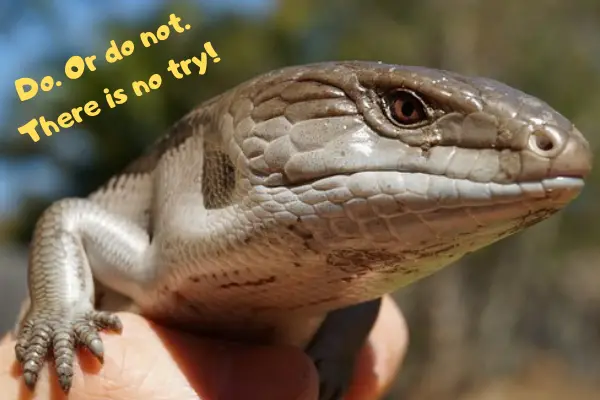
Table of Contents
The blue-tongued skink
The blue tonged (or tongue) skink, also called blue-tongued lizards, are a kind of skink that’s a common pet reptile. There are a lot of different varieties of these lizards that are available as pets, but the two most common are the northern blue-tongued skink and the Indonesian blue-tongued skink.
The care for blue-tongued skink species does differ slightly from one to another, so we’re going to do our best to create a care sheet that’s as complete as possible, covering both of these species as best we can.
If you find that we’ve left something out or you have any questions, please ask them in the comments. We’re always looking to improve the recourses on our site, so it would be much appreciated.
Blue tongue skink as a pet
Blue-tongued skinks are exactly what it says on the tin… They’re skinks with blue tongues. If you can roll your tongue up, you know what it’s like to have a cool party trick in your back pocket. These skinks have their blue tongue just in case they ever want to be the life of the party.
Anyway…
Blue-tongued skinks are great pets and are extremely popular too. Their docile and interesting temperament makes them a very rewarding species of lizard to keep as a pet.
Want to learn some cool facts about these animals? Check out our post on blue tongue skink facts!
Blue tongue lizards are great when it comes to handling. They’re still reptiles so it’s not advised to overdo it, but these little scavengers are easy to handle and, once they’re used to you, they are quite comfortable with you handling them.
These lizards also have quite the character and are a delight to sit and look at. They’re relatively adventurous too, so switching things up from time to time can help get your skink to demonstrate more natural behavior.
As already mentioned, there are two main species of blue-tongued skinks which are kept as pets. You can find a list of more species here, on Wikipedia.
Northern blue tongue skink
The northern blue tongue skink is a little larger than the Indonesian variety. These skinks are native to Australia, and specifically the northern area of the country (hence the name).
Since Australia doesn’t allow for any animals to be imported or exported, it’s almost 100% certain that, if you get a northern blue-tongued skink, it will be a captive-bred animal.
Captive-bred skinks are much more likely to be healthy and are a lot less likely to carry parasites. If they are captive-bred you also know where they came from which gives some peace of mind too. Wild-caught pets are usually more difficult to keep and also often carry parasites or diseases.
Northern blue-tongued skinks have lighter legs than the Indonesian variety, and they have a slightly different pattern. These northern blue-tongued lizards also need a different degree of humidity in their enclosure than the Indonesian ones, as they are obviously from a different climate.
Indonesian blue-tongued skink
The Indonesian blue-tongued skink is similar to the northern variety, only they come from New Guinea and some other surrounding islands. They live in the rainforests there and therefore require a much higher humidity level than the northern variety.
Indonesian blue-tongued skinks also have darker, almost black markings on their legs. This is a great way of telling the species apart. The Indonesian variety is also a little skinnier and smaller than its Australian counterpart, but if you haven’t seen both species and can’t compare them, this isn’t the best way of telling them apart.
Both the Indonesian blue-tongued lizard and the Australian blue-tongued lizard make for great pets. There also isn’t a huge amount of difference when it comes to their care, the main difference being humidity.
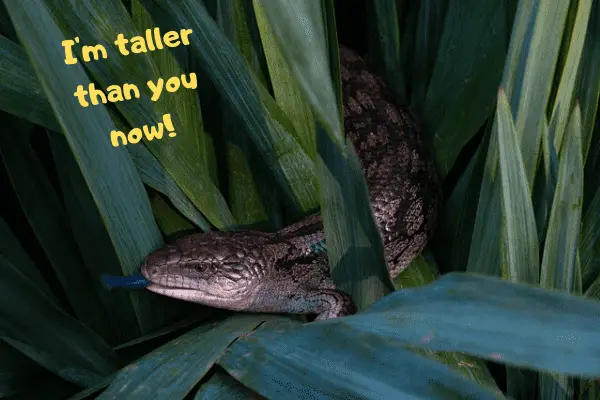
Blue tongue skink size
When it comes to the question of how big blue-tongued skinks get, it slightly depends on which one you have in front of you.
A blue-tongued skink’s size will also vary depending on its genes and their diet. Just like with us humans, there are a lot of different factors that influence their length and weight.
Indonesian blue-tongued skinks will generally reach a size of about 18 to 24 inches. An Australian blue tongue lizard averages out at about 17 to 24 inches. The Australian one is also generally bulkier than the Indonesian variety, weighing slightly more.
Blue tongue skink lifespan
When it comes to how long blue tongue skinks live, there isn’t much of a difference between the two. Blue tongue skinks can live to be 20 years old, so making the decision to buy one isn’t a decision to take lightly.
These skinks make great pets, but getting a pet skink without thinking carefully is definitely not a good idea.
Skinks make great pets but they don’t make great impulse buys!
A blue-tongued skink’s lifespan can vary a lot depending on how they are cared for, and also a bit of luck. However, if they are cared for properly, you should be able to enjoy this lizard’s blue tongue for a long time to come.
Blue tongued skink price
Blue tongue skinks can get quite expensive, depending on where you are located. Because these blue tongue lizards make such great pets, demand is high.
However, they are quite anti-social when it comes to their own kind and these lizards are notoriously hard to breed. They also don’t produce a lot of young which further reduces the supply of these wonderful lizards.
That being said, former zookeeper T.C. Houston from https://www.reptilemountain.com/ breeds blue tongues for a living. He had this to say when I emailed him on the topic:
They [Northerns] are surprisingly simple to keep and breed actually. Yes, my whole channel is dedicated to talking about care for the most part, however, I’m breaking down very simple concepts into even more simple ideas for beginners really.
If you know reptiles and how to keep them then breeding skinks is a cake walk. Yes, there are good and bad moments such as unexpected deaths, deformed babies, injuries from breeding (sometimes quite severe), but overall they are one of the easiest animals I’ve ever worked with. But then again, I’ve worked with some of the most challenging animals on the planet so I guess anything would be viewed as easy then right? LOL
If you really want to get into depth on how to care for blue tongue skinks, his youtube channel is the place to be!
You can expect to pay anywhere from $150 to $350 and up for a blue-tongued skink. It really depends where you live and what the age of the animal is.
Do blue tongue skinks bite?
They can do, but once they are used to being handled this usually doesn’t happen much. Blue tongue skinks have a heck of a bite for an animal which looks like a potato with no teeth.
Your blue tongue is best left alone if they are looking grumpy. That being said, it’s not dangerous and will only hurt for a little bit.
Are blue tongue skinks dangerous?
Unless you happen to be an insect these little lizards are in no way dangerous. Even though a bite can hurt a little bit (or a lot), they aren’t venomous or poisonous, and they aren’t large enough to do any major damage to us humans.
Do blue tongued lizards have teeth?
They do have teeth but they aren’t very large. Blue tongue skink teeth may not be large but they do have quite a powerful bite so take care when they are still getting used to handling.
Do blue tongue skinks shed?
Yes, as with most reptiles, blue tongue skinks do shed their skin. This enables them to grow and remove parasites from their skin and makes it possible for them to grow!
Do blue tongue skinks give birth to live young?
Surprisingly, yes! Blue tongue skinks do give birth to live young and that’s very unusual for lizards or any kind of reptile for that matter. This is one of the things that makes breeding them quite hard though, as they only give birth to a small number of young.
Blue tongue skink enclosure
A blue-tongued skink enclosure’s setup is quite basic, and they don’t have very extravagant needs. As we’ve already mentioned, humidity preferences differ slightly between the Indonesian and the Australian varieties, but tank-wise they fair well in the same kinds of setups.
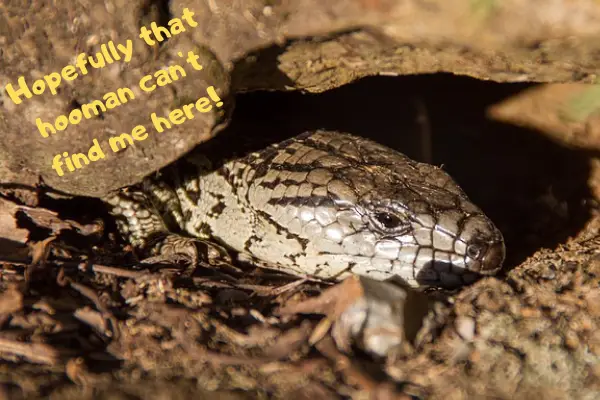
Blue tongue skink habitat
As we’ve already covered, a blue-tongued skinks habitat depends on where they are from. Indonesian blue tongue lizards come from a rainforest environment, while the northern blue-tongued skink lives in more savannah-like grasslands.
This habitat is something that’s usually best to try to replicate within your blue tongue’s enclosure.
Blue tongue skink tank size
When it comes to blue tongue skink tank size, there’s some disagreement. Generally, though, larger setups are considered better for most lizards.
An adult blue tongue skink needs to be kept in a tank that’s about 3 to 4 feet long. This will ensure they have ample space to move around in and will make it possible for you to see a more natural selection of behaviors from your skink.
Blue-tongued skinks aren’t avid climbers so they like to have a lot of ground space to move around on.
Substrate for blue tongue skink
Substrate for blue tongue skinks is another thing that’s often disagreed on. For starters, you’re going to want a different substrate for the Indonesian blue tongue skink than for the Australian variety.
This is because the substrate is a great way of manipulating the humidity of the enclosure and thus can provide the Indonesian skink with a higher humidity level.
Things like aspen and fir bark are often suggested for blue tongue skinks. A paper substrate also works well and prevents the humidity from getting too high. However, paper does look a little sterile and isn’t great for a display enclosure.
Things like sand and cat litter aren’t advised as they can lead to impaction and digestive problems for your pet skink. Impaction is when they eat so much of a foreign substance that they can’t pass it. This is very painful for your skink and can lead to an operation or death.
Blue tongue skink temperature and heating
Coming from Australia, blue tongue skinks need to have the possibility to stay warm. Like all reptiles, skinks are cold-blooded and cannot regulate their own body temperature.
Blue tongue lizards use thermoregulation to keep themselves at a healthy body temperature. This is done by moving between warm and colder areas in order to alter their body temperature.
You should always keep a cold and warm end in your skink enclosure. It’s best to keep the warm end at one side to make sure you have a clear temperature gradient throughout your blue tongue skink’s enclosure.
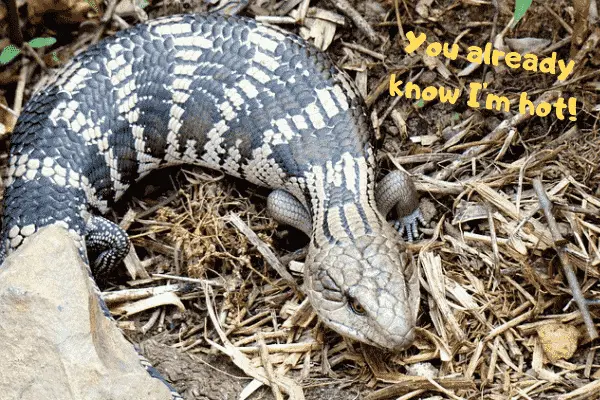
Temperature
When it comes to temperature, your blue tongue skink needs a temperature around the 80 degrees Fahrenheit (+/- 26 degrees Celsius) on the cool side. This can go as low as 75 degrees, or even a little lower during the night.
Obviously, the temperature is going to fluctuate slightly, just like the humidity will. This is ok and it’s the same in the wild. Just ensure it doesn’t spike or dip under or above the extremes given to prevent any problems.
Your little skink can’t turn up the heating or turn the air-conditioning on either. Even worse, it can’t even regulate its own body temperature so it’s 100% at your mercy!
The basking area of the terrarium should be roughly 95 to 102 degrees Fahrenheit (35-37.5 degrees Celsius).
There are a lot of different things that will have an impact on your blue tongue skinks enclosure temperature. These things don’t have to be linked to your setup, but can be “external” factors like the temperature of your room or the amount of extra air escaping by leaving the window open.
Get a good thermometer and a thermometer gun as well so you can measure both the temperature of the surfaces as well as the air.
This will help you to keep an eye on what kind of temperatures the enclosure is at.
Blue tongue skink heating
For heating, your best bet is to go with 2 heat bulbs. These should both be on the same end of the enclosure and you should aim for a temperature of about 95-102 degrees Fahrenheit.
Blue tongue skinks love hot temperatures and are used to basking to help them warm up and digest food. It’s also an important part of getting the right nutrients as we’ll see now.
Blue tongue skink UVB
When it comes to UVB, it’s kind of optional but kind of not. Reptiles like blue tongue skinks need UVB in order to create sufficient vitamin D3 levels.
Vitamin D helps the skinks to absorb the calcium in their food properly. If they don’t get enough calcium, or can’t absorb it, then you run the risk of your skink getting metabolic bone disease.
More on this topic at the end of this article, but it’s not pretty and definitely not something you’d wish on your pet skink!
However, you also have the option of providing sufficient vitamin D3 through supplementation. Even though this is possible, and it’s definitely recommended to do so, it’s also often recommended to supply a low-level of UVB lighting as well.
UVB lighting needs to be replaced regularly in order for it to stay effective. After about 4-6 months they run out and don’t supply enough UVB to your skink anymore. You can follow the instructions given to you and hope for the best…
However, you’re probably better off measuring the amount of UVB coming off the light. This way you can make sure your skink is producing enough vitamin D3!
If you’re supplying most of the D3 in their diet and are only using UVB lighting as a bonus, you probably don’t need to be as precise with it!
More on supplementation on the part about diet, but you’ve got to do either one or the other to prevent nasty cases illness in your skink.
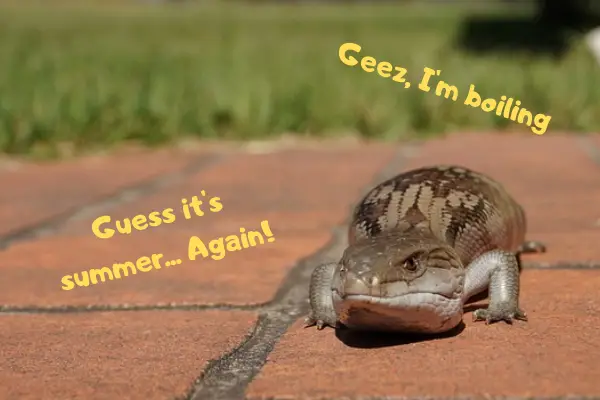
Blue tongue skink humidity
When it comes to humidity there’s a lot of difference between the northern blue tongue skink and the Indonesian blue tongue skink.
As we’ve already covered, the Indonesian variety will need a much higher level of humidity than the northern (Australian) variety.
Northern blue tongue skinks can be kept in humidity levels around 30-50%. Humidity can be difficult to keep steady, especially in large enclosures, but occasional dips and spikes aren’t too much of an issue.
That being said, it’s best to shoot for something within this range all the time to keep these spikes and dips to a minimum.
If your humidity is on the low end it sometimes happens that your blue tongue skink can get dry scales on the bottom of their body. By providing a moist(er) hide, this can be prevented.
Your blue-tongued lizard will then automatically visit that hide when they feel like their belly could do with some moisture.
This hide also doubles as a great place for them to go when they’re shedding. But more on that a little later…
Do blue tongue skinks bask?
Yes, although this will depend slightly on the temperature you’re keeping the enclosure at and your skink’s personality.
If you want to use UVB lighting as the main source of their vitamin D synthesis then you’ll surely see them basking.
Do blue tongue skinks need a heat lamp?
Yes. Both of the commonly kept species of blue tongue skink will need a heat lamp in order to provide the right temperature on the hot side of their enclosure.
Do blue tongue skinks need heat at night?
They don’t need heating at night as long as the temperature doesn’t drop to extremes. Read the part about blue tongue skink heating to find out exactly what kind of temperature your blue tongue needs at night!
If you live in a particularly cold area, a heat mat can offer heating at night without the bright lights.
Blue tongue skink diet
A skink’s gonna eat what a skink’s gonna eat. Whether in the wild or in captivity, blue tongue skinks have rather peculiar feeding habits.
In the wild these animals are opportunists. They live off pretty much anything edible they can get their little lizard hands on and have been known to eat insects, fruits, plants, and even other skinks, small mammals, and poo!
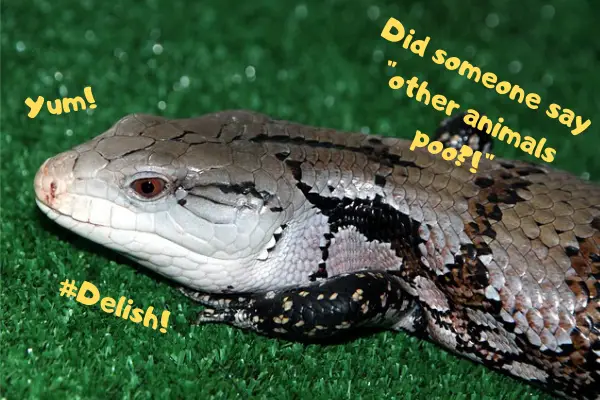
These animals truly are walking garbage disposers!
Blue tongue skink feeding in captivity
In captivity, you obviously aren’t going to be feeding them poo, but you can do quite well with ingredients found in your grocery store.
That being said, there is one food that beats them all when it comes to nutrition for your skink…
Wet dog food (or cat food).
Not all sorts will work well, but it’s widely accepted that dog food is extremely nutritious for your skink.
At least make sure that the dog food is wet/canned and doesn’t contain grains though, as this isn’t part of a healthy diet for blue tongues. Dog/cat food usually contains a varied diet consisting of both vegetables and proteins for your skink.
There’s more to feeding a healthy varied diet to your blue tongue skink than just dog food, but it truly is a huge staple in most healthy skink’s diet.
You can also use commercially available skink food, but it’s best to mix things up and include it as part of a varied diet.
As well as dog food, you can add some vegetables into the mix. This will help to increase the nutritional value of your blue tongue’s diet.
As well as vegetables, you can add some insects into your blue tongue skink’s diet too.
The standard insects work well, so things like super worms, dubia roaches, slugs, hornworms and earthworms all work great.
Remember, make sure that you buy these insects from a breeder and you don’t feed your skink insects you find outside. These could have parasites or have pesticides on them which will harm your skink!
It’s important to feed a healthy and varied diet to your blue tongue skink in order to keep them healthy. Being opportunists in the wild, they are used to eating a lot of different things.
What not to feed you blue tongue skink
- Too much fruit!
Using fruit as a treat for your skink is great. However, too much fruit is extremely detrimental to your blue tongue. It can flood their body with the wrong kind of nutrients and can damage their digestive system.
- Dog food with (too much) grain
The grain has pretty much no value to your skink. Them filling up with grains may help them reduce their hunger but it won’t give them the nutrients they need. This can cause health issues down the line!
If you want an all-inclusive list of things to feed your blue tongue skink, there’s a wicked care guide here.
Water
When caring for a blue tongue skink, water is something you can’t forget. It’s vital that your blue tongue skink has clean water to drink whenever they need to hydrate themselves.
It’s best to provide a shallow dish of water in their enclosure at all times to ensure they can always drink when they need to. Water should be changed regularly and make sure to keep an eye on if there are any contaminants in the water.
Faeces or old food in the water can harm your skink if not cleaned regularly. It can release ammonia and that’s not a good thing!
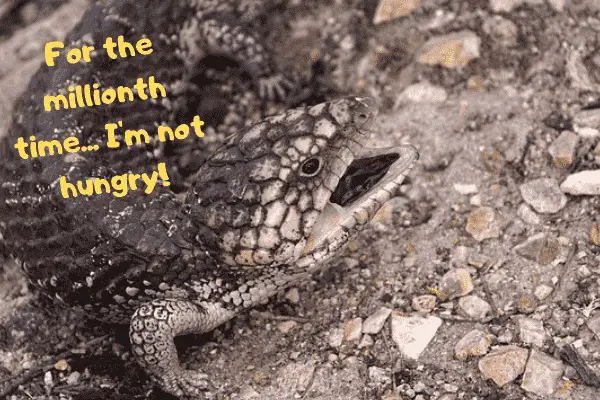
Blue tongue skink not eating
If your blue tongue skink isn’t eating, it’s probably not hungry. These lizards really aren’t too picky when it comes to their grub and a skink that doesn’t want to eat, or is only eating certain foods are probably just not hungry.
That being said, there could be certain things in the husbandry (care) for your blue tongue skink that are causing this behavior.
Check to see if their enclosure is at the right temperature, if they have enough hiding spaces and they are in a relatively calm environment.
Scan through this care guide and see if there may be other things that are going wrong when it comes to your skink husbandry.
If you can’t find anything and your skink really isn’t eating and is losing weight, take them to the vet!
You should try and keep an eye on your skink’s weight to ensure that you don’t leave vet visits until too late!
Blue tongue skink shedding
As with most reptiles, blue tongue skinks shed their skin. You’ll notice this process take effect once the skink’s color starts to get duller and skin starts loosening.
These skinks are quite easy shedders and don’t normally require very much help if cared for properly. Make sure your skink has a moist hide and the humidity is slightly higher than normal. This will greatly help with the natural shedding process.
When it comes to your blue tongue skink shedding, on occasions you may have to help out a little around the tail and toes. If the skin stays on there then it can cause problems with blood flow and cause toes to fall off.
You can do this by placing your skink in a very shallow pool of lukewarm water (not above their ankle height and not too hot!). They aren’t great swimmers and aren’t fans of water so be careful.
After a little while, you can place them back into their enclosure. If all’s well the shed should fall off within a few hours. If it doesn’t come off then repeat the process.
Should both moist hides and water not help, you can use a cotton bud or your hand to ever-so-gently help removing the skin.
This is a last resort and really should not be necessary if they’re getting the right habitat and diet conditions.
Blue tongue skink handling
If you’ve just got your blue-tongued skink then its probably not used to being handled. There are even some skinks who are a lot older and still don’t like handling. There are two main things to keep in mind when it comes to handling a blue tongue skink.
- These are not dogs or cats
Reptiles will not get as domestic as dogs or cats do. Blue tongues aren’t social animals and them being ok with you handling them should be the goal.
- Take it slow!
If you’ve only just got your blue tongue then take it easy. Let them acclimatize a little bit and get used to their new surroundings. Once they’ve gotten used to their location you can start getting them used to you handling them.
So, we’ve got these two things out of the way, let’s get to dealing with the hissing, lunging and running skinks!
For starters, if you’re worried you’re going to get bitten, use something soft to shield your hands with. This will prevent you from getting bitten and prevent your pet skink from damaging their mouth.
Another thing that will help is having an enclosure that opens from the side. Most lizards are preyed on by birds, so coming in from the top can cause more stress in your animal.
Apart from these tips, it’s really a question of getting them into your hands. A lot of skinks will be ok once they are in your hand, they just don’t like being picked up.
Once they’re in your hand, most blue tongues will calm down quickly. You can then let them get used to you holding them.
Moving slowly will also help to prevent you from scaring them or putting them more on edge. Loud noise is another thing that can cause them to be more stressed out, so it’s best to stay calm when first handling your pet skink.
When you first start handling your blue tongue skink, do it in short bursts. Don’t keep them in your hands for too long. Do it regularly and in short bursts. This is the only and best way to get your skink used to being handled.
Our post on the best pet lizards includes more great pet lizards for handling.
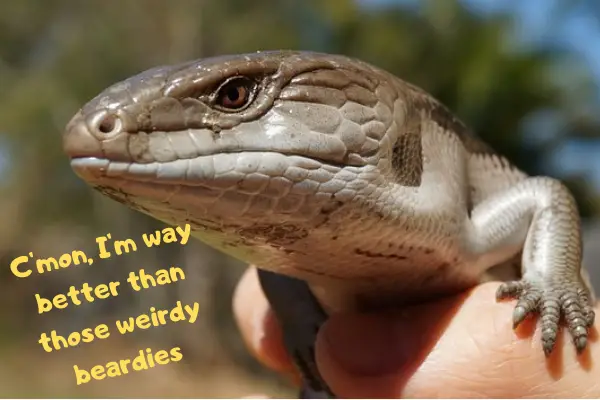
Blue tongue skink vs bearded dragon
The age-old matchup: Blue tongue skink vs bearded dragon. It’s not an easy matchup to compare, but there are some advantages of each that we can cover quickly.
The first thing when it comes to the blue tongue skink vs bearded dragons is that blue tongue skinks are less widely owned or available. This can make them a little more pricey too.
That being said, bearded dragons when growing up are extremely expensive when it comes to feeding.
In regards to which makes the better pet, there’s really no way to say. Both of these reptiles make great pets and either one is extremely rewarding.
Learn more about the differences and what it’s like keeping a bearded dragon as a pet here!
Blue tongue skink health issues
Mouth rot in blue tongue skinks
Mouth rot is an illness in blue tongue skinks which needs attention asap to prevent any complications. You can tell when your blue tongue skink has mouth rot due to inflammation and even bleeding from their gums and mouth area.
There are two things you need to do when you notice these symptoms in your blue-tongued skink.
The first is to take them to the vet. Your reptile vet will know how to treat this. It’s not recommended to try any home-remedies for a disease like this.
The second is the ensure that your skink care is on point. Clean the terrarium out and ensure everything is sterilized to prevent infection. After that, make sure that you are providing all the right nutrients in the form of both lighting and diet.
Scale rot in your skink
Scale rot is exactly what it sounds like and is not at all pleasant. It is often down to poor care for your skink and can be prevented by good living conditions and checking them regularly for injuries.
Should you see a case of scale rot in your skink (usually on the underside of their body), it’s on you to judge how bad it is. If you’re unsure, visit your vet and they will know what to do.
If it’s in the very early stages, check your husbandry and ensure that your skink is kept in great conditions. With scale rot, this often means checking humidity more than anything. Also removing any potential bacteria causing the scale rot from the enclosure, or even supplying a completely new enclosure is necessary to prevent the scale rot from getting worse.
If these things don’t help, visit the vet!
Blue tongue skink respiratory infection
Blue tongues are hardy lizards, and most of these diseases are rare. The same can be said for respiratory infections too.
However, they can occur and need to be dealt with.
As with all of these illnesses, it’s best to consult with your vet first. Your vet is there to help with illnesses and diseases like this.
Respiratory infections are often down to husbandry problems. A too high or too low level of humidity is a big culprit. Poor nutrition and stress are also common causes.
If you think that your skink has a respiratory infection, visit the vet and check to see what the cause is so you can eliminate it in the future.
Conclusion
That was a lot to digest…
As you can see, blue tongue skink care is a vast subject with a lot to take in. Give this guide another read if you’re not certain about some aspects of skink care. We also encourage you to look at other information sources to make sure you know everything you can about caring for your blue tongue skink.
If there’s anything you feel we’ve left out of this guide, please send us a message. If there are any questions then please leave them in the comments so that everyone can benefit from the answers. WE’re always looking to improve our resources!
